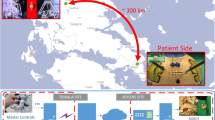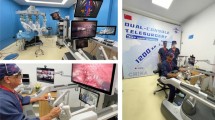Abstract
Background
5G communication technology has been applied to several fields in telemedicine, but its effectiveness, safety, and stability in remote laparoscopic telesurgery have not been established. Here, we conducted four ultra-remote laparoscopic surgeries on a swine model under the 5G network. The aim of the study was to investigate the effectiveness, safety, and stability of the 5G network in remote laparoscopic telesurgery.
Methods
Four ultra-remote laparoscopic surgeries (network communication distance of nearly 3000 km), including left nephrectomy, partial hepatectomy, cholecystectomy, and cystectomy, were performed on a swine model with a 5G wireless network connection using a domestically produced “MicroHand” surgical robot. The average network delay, operative time, blood loss, and intraoperative complications were recorded.
Results
Four laparoscopic telesurgeries were safely performed through a 5G network, with an average network delay of 264 ms (including a mean round-trip transporting delay of 114 ms and a 1.20% data packet loss ratio). The total operation time was 2 h. The total blood loss was 25 ml, and no complications occurred during the procedures.
Conclusions
Ultra-remote laparoscopic surgery can be performed safely and smoothly with 5G wireless network connection using domestically produced equipment. More importantly, our model can provide insights for promoting the future development of telesurgery, especially in areas where Internet cables are difficult to lay or cannot be laid.




Similar content being viewed by others
References
Hung AJ, Chen J, Shah A, Gill IS (2018) Telementoring and telesurgery for minimally invasive procedures. J Urol 199:355–369
Nguan C, Miller B, Patel R, Luke PP, Schlachta CM (2008) Pre-clinical remote telesurgery trial of a da Vinci telesurgery prototype. Int J Med Robot 4:304–309
Sterbis JR, Hanly EJ, Herman BC, Marohn MR, Broderick TJ, Shih SP, Harnett B, Doarn C, Schenkman NS (2008) Transcontinental telesurgical nephrectomy using the da Vinci robot in a porcine model. Urology 71:971–973
Choi PJ, Oskouian RJ, Tubbs RS (2018) Telesurgery: past, present, and future. Cureus 10:e2716
Marescaux J, Leroy J, Gagner M, Rubino F, Mutter D, Vix M, Butner SE, Smith MK (2001) Transatlantic robot-assisted telesurgery. Nature 413:379–380
Marescaux J, Leroy J, Rubino F, Smith M, Vix M, Simone M, Mutter D (2002) Transcontinental robot-assisted remote telesurgery: feasibility and potential applications. Ann Surg 235:487–492
Arata J, Takahashi H, Pitakwatchara P, Warisawa SI, Konishi K, Tanoue K, Ieiri S, Shimizu S, Nakashima N, Okamura K, Kim Y, Kim S, Hahm J, Hashizume M, Mitsuishi M (2007) A remote surgery experiment between Japan-Korea using the minimally invasive surgical system. In: Magjarevic R, Nagel JH (eds) World congress on medical physics and biomedical engineering 2006. IFMBE Proceedings, vol 14. Springer, Berlin, pp 3065–3068
Lum MJH, Friedman DCW, Sankaranarayanan G, King H, Fodero K, Leuschke R, Hannaford B, Rosen J, Sinanan MN (2009) The RAVEN: design and validation of a telesurgery system. Int J Robot Res 28:1183–1197
Garcia P, Rosen J, Kapoor C, Noakes M, Elbert G, Treat M, Ganous T, Hanson M, Manak J, Hasser C, Rohler D, Satava R (2009) Trauma pod: a semi-automated telerobotic surgical system. Int J Med Robot 5:136–146
Lefranc M, Peltier J (2016) Evaluation of the ROSA Spine robot for minimally invasive surgical procedures. Expert Rev Med Devices 13:899–906
Abdel Raheem A, Troya IS, Kim DK, Kim SH, Won PD, Joon PS, Hyun GS, Rha KH (2016) Robot-assisted fallopian tube transection and anastomosis using the new REVO-I robotic surgical system: feasibility in a chronic porcine model. BJU Int 118:604–609
Fanfani F, Monterossi G, Fagotti A, Rossitto C, Gueli Alletti S, Costantini B, Gallotta V, Selvaggi L, Restaino S, Scambia G (2016) The new robotic TELELAP ALF-X in gynecological surgery: single-center experience. Surg Endosc 30:215–221
Moglia A, Ferrari V, Morelli L, Ferrari M, Mosca F, Cuschieri A (2016) A systematic review of virtual reality simulators for robot-assisted surgery. Eur Urol 69:1065–1080
Yi B, Wang G, Li J, Jiang J, Son Z, Su H, Zhu S, Wang S (2017) Domestically produced chinese minimally invasive surgical robot system "Micro Hand S" is applied to clinical surgery preliminarily in china. Surg Endosc 31:487–493
Yi B, Wang G, Li J, Jiang J, Son Z, Su H, Zhu S (2016) The first clinical use of domestically produced chinese minimally invasive surgical robot system "Micro Hand S". Surg Endosc 30:2649–2655
Martín-Sacristán D, Monserrat JF, Cabrejas-Peñuelas J, Calabuig D, Garrigas S, Cardona N (2009) On the way towards fourth-generation mobile: 3GPP LTE and LTE-advanced. EURASIP J Wirel Commun Netw 2009:354089
Zhou Y, Ling L, Du H, Tian L, Wang X, Shi J (2015) An overview on intercell interference management in mobile cellular networks: from 2G to 5G. In: 2014 IEEE international conference on communication systems, IEEE ICCS, vol 2014. IEEE, Macau, pp 217–221
Parkvall S, Furuskär A, Dahlman E (2011) Evolution of LTE toward IMT-advanced. IEEE Commun Mag 49:84–91
Martinez AW, Phillips ST, Carrilho E, Thomas SW 3rd, Sindi H, Whitesides GM (2008) Simple telemedicine for developing regions: camera phones and paper-based microfluidic devices for real-time, off-site diagnosis. Anal Chem 80:3699–3707
Demaerschalk BM, Miley ML, Kiernan TE, Bobrow BJ, Corday DA, Wellik KE, Aguilar MI, Ingall TJ, Dodick DW, Brazdys K, Koch TC, Ward MP, Richemont PC, Coinvestigators S (2009) Stroke telemedicine. Mayo Clin Proc 84:53–64
Weinstein RS, Lopez AM, Joseph BA, Erps KA, Holcomb M, Barker GP, Krupinski EA (2014) Telemedicine, telehealth, and mobile health applications that work: opportunities and barriers. Am J Med 127:183–187
Kim DK, Yoo SK, Park IC, Choa M, Bae KY, Kim YD, Heo JH (2009) A mobile telemedicine system for remote consultation in cases of acute stroke. J Telemed Telecare 15:102–107
Bolsi A, Lomax AJ, Pedroni E, Goitein G, Hug E (2008) Experiences at the paul scherrer Institute with a remote patient positioning procedure for high-throughput proton radiation therapy. Int J Radiat Oncol Biol Phys 71:1581–1590
Heslop L, Weeding S, Dawson L, Fisher J, Howard A (2010) Implementation issues for mobile-wireless infrastructure and mobile health care computing devices for a hospital ward setting. J Med Syst 34:509–518
Chan FY, Whitehall J, Hayes L, Taylor A, Soong B, Lessing K, Cincotta R, Cooper D, Stone M, Lee-Tannock A, Baker S, Smith M, Green E, Whiting R (1999) Minimum requirements for remote realtime fetal tele-ultrasound consultation. J Telemed Telecare 5:171–176
Su L, Dong Q, Zhang H, Zhou X, Chen Y, Hao X, Li X (2016) Clinical application of a three-dimensional imaging technique in infants and young children with complex liver tumors. Pediatr Surg Int 32:387–395
Gao Y, Hu J, Zhang X, Zhang M, Wang D, Zheng X, Liu S, Lu Y (2019) Use of hisense computer-assisted surgery system enhances infrapyloric lymph node dissection for gastric cancer. J Surg Res 242:31–39
Rayman R, Croome K, Galbraith N, McClure R, Morady R, Peterson S, Smith S, Subotic V, Van Wynsberghe A, Patel R, Primak S (2007) Robotic telesurgery: a real-world comparison of ground- and satellite-based internet performance. Int J Med Robot 3:111–116
Haidegger T, Sandor J, Benyo Z (2011) Surgery in space: the future of robotic telesurgery. Surg Endosc 25:681–690
Wirz R, Torres LG, Swaney PJ, Gilbert H, Alterovitz R, Webster RJ 3rd, Weaver KD, Russell PT 3rd (2015) An experimental feasibility study on robotic endonasal telesurgery. Neurosurgery 76:479–484 (discussion 484)
Nguan CY, Morady R, Wang C, Harrison D, Browning D, Rayman R, Luke PP (2008) Robotic pyeloplasty using internet protocol and satellite network-based telesurgery. Int J Med Robot 4:10–14
Xu S, Perez M, Yang K, Perrenot C, Felblinger J, Hubert J (2014) Determination of the latency effects on surgical performance and the acceptable latency levels in telesurgery using the dV-Trainer((R)) simulator. Surg Endosc 28:2569–2576
Miao Y, Jiang Y, Peng L, Hossain MS, Muhammad G (2018) Telesurgery robot based on 5G tactile internet. Mobile Netw Appl 23:1645–1654
Acknowledgements
This work was supported by National Natural Science Foundation of China (81772713, 81972378, 81981260351, 81472411), Qingdao People's Life Science and Technology Project (18-6-1-64-nsh), Major Scientific and Technological Innovation Project of Shandong Province (2019JZZY021002).
Author information
Authors and Affiliations
Contributions
HN designed the research; HN and WG performed the telesurgeries; XY, LL, WJ, ZY, MZ, FX, YJ, BL, and XH assisted the telesurgeries; LZ, ZY, and CW analyzed the data; JZ, YW, and JZ wrote the manuscript; QD, ZL, and HN edited the manuscript; all authors reviewed and approved the manuscript.
Corresponding author
Ethics declarations
Disclosures
Jilu Zheng, Yonghua Wang, Jian Zhang, Weidong Guo, Xuecheng Yang, Lei Luo, Wei Jiao, Xiao Hu, Zongyi Yu, Chen Wang, Ling Zhu, Ziyi Yang, Mingxin Zhang, Fei Xie, Yuefeng Jia, Bin Li, Zhiqiang Li, Qian Dong, and Haitao Niu declare that they have no conflicts of interest or financial ties to disclose.
Additional information
Publisher's Note
Springer Nature remains neutral with regard to jurisdictional claims in published maps and institutional affiliations.
Electronic supplementary material
Below is the link to the electronic supplementary material.
Rights and permissions
About this article
Cite this article
Zheng, J., Wang, Y., Zhang, J. et al. 5G ultra-remote robot-assisted laparoscopic surgery in China. Surg Endosc 34, 5172–5180 (2020). https://doi.org/10.1007/s00464-020-07823-x
Received:
Accepted:
Published:
Issue Date:
DOI: https://doi.org/10.1007/s00464-020-07823-x




